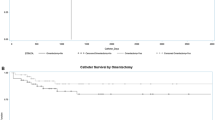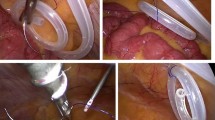Abstract
Background
Obesity has been considered a relative contraindication to peritoneal dialysis (PD). Surprisingly, PD catheter dysfunction rates and longevity have not been studied in the growing obese ESRD population. The aim of this study was to determine the effect of patient weight on PD catheter survival in the three insertion technique categories of advanced laparoscopy (AL), basic laparoscopy (BL), and open.
Methods
We examine retrospectively collected data on 231 consecutive PD catheter insertions at the NorthShore University HealthSystem between 2004 and 2014. Three cohorts were created based on the catheter insertion technique: open, BL using selective adhesiolysis, and AL using rectus sheath tunnel, selective omentopexy, and adhesiolysis. Primary outcomes included catheter dysfunction and catheter dysfunction-free survival for each cohort by BMI: normal weight (18.5–24.9), overweight (25–29.9), obese (≥30). Nominal variables were compared using Chi-square test, continuous variables using ANOVA or Kruskal–Wallis tests, and catheter survival was assessed using the Kaplan–Meier method with log-rank test. Statistical significance was established at 0.05.
Results
For the three BMI categories, there were no statistically significant differences in patient demographics. There were no statistically significant differences in catheter dysfunction or peri-operative complications by BMI category among all patients. This was also true in the AL cohort. Among all patients, similar 2-year dysfunction-free catheter survival was noted for normal weight, overweight, and obese patients (log-rank p = 0.79). This was also true across all insertion techniques: open (log-rank p = 0.87), BL (log-rank p = 0.41), AL (log-rank p = 0.43). In the obese cohort, the 2-year dysfunction-free catheter survival was 91.1% in AL, 83.5% in BL, and 65.7% in open (log-rank p = 0.58).
Conclusion
Obesity does not increase complications or shorten dysfunction-free PD catheter survival regardless of the operative technique used. Obesity should not be considered as a relative contraindication to PD catheter placement as it confers similar technique success to normal- and overweight individuals.

Similar content being viewed by others
References
Adult Obesity Facts | Overweight & Obesity | CDC. https://www.cdc.gov/obesity/data/adult.html. Accessed 21 Mar 2017
Kramer HJ, Saranathan A, Luke A, Durazo-Arvizu RA, Guichan C, Hou S, Cooper R (2006) Increasing body mass index and obesity in the incident ESRD population. J Am Soc Nephrol JASN 17:1453–1459. doi:10.1681/ASN.2005111241
United States Renal Data System (2015) USRDS annual data report: epidemiology of kidney disease in the United States
Hsu C, McCulloch CE, Iribarren C, Darbinian J, Go AS (2006) Body mass index and risk for end-stage renal disease. Ann Intern Med 144:21–28
(1997) NKF-DOQI clinical practice guidelines for peritoneal dialysis adequacy. National Kidney Foundation. Am J Kidney Dis 30:S67–136
Snyder JJ, Foley RN, Gilbertson DT, Vonesh EF, Collins AJ (2003) Body size and outcomes on peritoneal dialysis in the United States. Kidney Int 64:1838–1844. doi:10.1046/j.1523-1755.2003.00287.x
Nolph KD, Jensen RA, Khanna R, Twardowski ZJ (1994) Weight limitations for weekly urea clearances using various exchange volumes in continuous ambulatory peritoneal dialysis. Perit Dial Int J Int Soc Perit Dial 14:261–264
McDonald SP, Collins JF, Johnson DW (2003) Obesity is associated with worse peritoneal dialysis outcomes in the Australia and New Zealand patient populations. J Am Soc Nephrol JASN 14:2894–2901
McDonald SP, Collins JF, Rumpsfeld M, Johnson DW (2004) Obesity is a risk factor for peritonitis in the Australian and New Zealand peritoneal dialysis patient populations. Perit Dial Int J Int Soc Perit Dial 24:340–346
Aslam N, Bernardini J, Fried L, Piraino B (2002) Large body mass index does not predict short-term survival in peritoneal dialysis patients. Perit Dial Int J Int Soc Perit Dial 22:191–196
Johnson DW, Herzig KA, Purdie DM, Chang W, Brown AM, Rigby RJ, Campbell SB, Nicol DL, Hawley CM (2000) Is obesity a favorable prognostic factor in peritoneal dialysis patients? Perit Dial Int J Int Soc Perit Dial 20:715–721
Badve SV, Paul SK, Klein K, Clayton PA, Hawley CM, Brown FG, Boudville N, Polkinghorne KR, McDonald SP, Johnson DW (2014) The association between body mass index and mortality in incident dialysis patients. PLoS ONE 9:e114897. doi:10.1371/journal.pone.0114897
Ladhani M, Craig JC, Irving M, Clayton PA, Wong G (2016) Obesity and the risk of cardiovascular and all-cause mortality in chronic kidney disease: a systematic review and meta-analysis. Nephrol Dial Transplant. doi:10.1093/ndt/gfw075
Shibagaki Y, Faber MD, Divine G, Shetty A (2002) Feasibility of adequate solute clearance in obese patients on peritoneal dialysis: a cross-sectional study. Am J Kidney Dis 40:1295–1300. doi:10.1053/ajkd.2002.36904
Boyle SM, Li Y, Wilson FP, Glickman JD, Feldman HI (2017) Association of alternative approaches to normalizing peritoneal dialysis clearance with mortality and technique failure: a retrospective analysis using the United States renal data system-dialysis morbidity and mortality study, wave 2. Perit Dial Int J Int Soc Perit Dial 37:85–93. doi:10.3747/pdi.2015.00227
Piraino B, Bernardini J, Centa PK, Johnston JR, Sorkin MI (1991) The effect of body weight on CAPD related infections and catheter loss. Perit Dial Int J Int Soc Perit Dial 11:64–68
Nessim SJ, Komenda P, Rigatto C, Verrelli M, Sood MM (2013) Frequency and microbiology of peritonitis and exit-site infection among obese peritoneal dialysis patients. Perit Dial Int J Int Soc Perit Dial 33:167–174. doi:10.3747/pdi.2011.00244
Krezalek MA, Bonamici N, Lapin B, Carbray J, Velasco J, Denham W, Linn J, Ujiki M, Haggerty SP (2016) Laparoscopic peritoneal dialysis catheter insertion using rectus sheath tunnel and selective omentopexy significantly reduces catheter dysfunction and increases peritoneal dialysis longevity. Surgery 160:924–935. doi:10.1016/j.surg.2016.06.005
Shahbazi N, McCormick BB (2011) Peritoneal dialysis catheter insertion strategies and maintenance of catheter function. Semin Nephrol 31:138–151. doi:10.1016/j.semnephrol.2011.01.003
Mujais S, Story K (2006) Peritoneal dialysis in the US: evaluation of outcomes in contemporary cohorts. Kidney Int. doi:10.1038/sj.ki.5001912
Attaluri V, Lebeis C, Brethauer S, Rosenblatt S (2010) Advanced laparoscopic techniques significantly improve function of peritoneal dialysis catheters. J Am Coll Surg 211:699–704. doi:10.1016/j.jamcollsurg.2010.08.010
Crabtree JH, Burchette RJ (2009) Effective use of laparoscopy for long-term peritoneal dialysis access. Am J Surg 198:135–141. doi:10.1016/j.amjsurg.2008.10.019
Moist LM, Port FK, Orzol SM, Young EW, Ostbye T, Wolfe RA, Hulbert-Shearon T, Jones CA, Bloembergen WE (2000) Predictors of loss of residual renal function among new dialysis patients. J Am Soc Nephrol JASN 11:556–564
Tam P (2009) Peritoneal dialysis and preservation of residual renal function. Perit Dial Int J Int Soc Perit Dial 29(Suppl 2):S108–S110
Rubin HR, Fink NE, Plantinga LC, Sadler JH, Kliger AS, Powe NR (2004) Patient ratings of dialysis care with peritoneal dialysis vs hemodialysis. JAMA 291:697–703. doi:10.1001/jama.291.6.697
Juergensen E, Wuerth D, Finkelstein SH, Juergensen PH, Bekui A, Finkelstein FO (2006) Hemodialysis and peritoneal dialysis: patients’ assessment of their satisfaction with therapy and the impact of the therapy on their lives. Clin J Am Soc Nephrol CJASN 1:1191–1196. doi:10.2215/CJN.01220406
Fenton SS, Schaubel DE, Desmeules M, Morrison HI, Mao Y, Copleston P, Jeffery JR, Kjellstrand CM (1997) Hemodialysis versus peritoneal dialysis: a comparison of adjusted mortality rates. Am J Kidney Dis 30:334–342
Heaf JG, Løkkegaard H, Madsen M (2002) Initial survival advantage of peritoneal dialysis relative to haemodialysis. Nephrol Dial Transplant 17:112–117
Davis WT, Dageforde LA, Moore DE (2014) Laparoscopic versus open peritoneal dialysis catheter insertion cost analysis. J Surg Res 187:182–188. doi:10.1016/j.jss.2013.09.041
Klarenbach SW, Tonelli M, Chui B, Manns BJ (2014) Economic evaluation of dialysis therapies. Nat Rev Nephrol 10:644–652. doi:10.1038/nrneph.2014.145
Shih Y-CT, Guo A, Just PM, Mujais S (2005) Impact of initial dialysis modality and modality switches on Medicare expenditures of end-stage renal disease patients. Kidney Int 68:319–329. doi:10.1111/j.1523-1755.2005.00413.x
Prasad N, Sinha A, Gupta A, Sharma RK, Bhadauria D, Chandra A, Prasad KN, Kaul A (2014) Effect of body mass index on outcomes of peritoneal dialysis patients in India. Perit Dial Int J Int Soc Perit Dial 34:399–408. doi:10.3747/pdi.2013.00056
Unal A, Hayri Sipahioglu M, Kocyigit I, Elmali F, Tokgoz B, Oymak O (2014) Does body mass index affect survival and technique failure in patients undergoing peritoneal dialysis? Pak J Med Sci 30:41–44. doi:10.12669/pjms.301.3807
Singh N, Davidson I, Minhajuddin A, Gieser S, Nurenberg M, Saxena R (2010) Risk factors associated with peritoneal dialysis catheter survival: a 9-year single-center study in 315 patients. J Vasc Access 11:316–322
Hsieh Y-P, Chang C-C, Wen Y-K, Chiu P-F, Yang Y (2014) Predictors of peritonitis and the impact of peritonitis on clinical outcomes of continuous ambulatory peritoneal dialysis patients in Taiwan–10 years’ experience in a single center. Perit Dial Int J Int Soc Perit Dial 34:85–94. doi:10.3747/pdi.2012.00075
Author information
Authors and Affiliations
Corresponding author
Ethics declarations
Disclosures
Stephen P. Haggerty has following disclosures: consultant and speaker for Covidien and Medtronic Since 2013, Honorarium from Bard 2013. Monika Krezalek, Nicolas Bonamici, Brittany Lapin, JoAnn Carbray, Jose Velasco, Woody Denham, John Linn, and Michael Ujiki have no conflict of interest or financial ties to disclose.
Electronic supplementary material
Below is the link to the electronic supplementary material.
Rights and permissions
About this article
Cite this article
Krezalek, M.A., Bonamici, N., Kuchta, K. et al. Peritoneal dialysis catheter function and survival are not adversely affected by obesity regardless of the operative technique used. Surg Endosc 32, 1714–1723 (2018). https://doi.org/10.1007/s00464-017-5852-y
Received:
Accepted:
Published:
Issue Date:
DOI: https://doi.org/10.1007/s00464-017-5852-y




